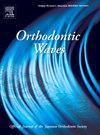Artefact of fixed orthodontic auxiliary appliance in craniofacial CT image
IF 0.5
Q4 DENTISTRY, ORAL SURGERY & MEDICINE
引用次数: 0
Abstract
ABSTRACT Purpose. The study aimed to evaluate the artefacts from different types of fixed orthodontic auxiliary appliance. Methodology. This is an in-vitro cross-sectional study. Six different types of the fixed auxiliary appliance were placed consecutively into a cadaveric skull head in combination with orthodontic brackets. All scans were performed by a single operator using the same CT machine followed by a standard scanning protocol. Artefact intensity for all data sets was quantified by calculating the standard deviation (SD) of the grey values within the dataset by following a standard method. All the axial slices were divided into two anatomical zones according to the Frankfort horizontal (FH) plane. The zone-A covered the axial slices which were above the FH plane and zone B consist of axial slices which were below the FH plane One-way ANOVA Tamhane test was used for the data analysis. The level of significance (p) was set at 0.05. Result. The mean artefact score of CT images with the fixed orthodontic auxiliary appliances was significantly higher than the control images at zone B. In addition, there was no significant difference (p = 0.061) observed between the CT images with fixed orthodontic auxiliary appliances and control images within the zone A. Conclusion. Fixed orthodontic auxiliary appliances produced a significant amount of noise below the FH plane and removal of this appliance before a CT scan will improve the image quality significantly within the area.固定式正畸辅助矫治器在颅面CT图像中的应用
摘要目的。本研究旨在评估不同类型固定正畸辅助矫治器的伪影。方法论这是一项体外横断面研究。六种不同类型的固定辅助矫治器被连续放置在尸体颅骨中,并结合正畸托槽。所有扫描均由一名操作员使用相同的CT机器进行,并遵循标准扫描协议。通过遵循标准方法计算数据集中灰度值的标准差(SD),对所有数据集的Artefact强度进行量化。根据Frankfort水平面(FH)将所有轴向切片分为两个解剖区。区域A覆盖FH平面上方的轴向切片,区域B由FH平面下方的轴向切片组成。数据分析采用单向方差分析Tamhane检验。显著性水平(p)设定为0.05。后果在B区,使用固定正畸辅助矫治器的CT图像的平均伪影得分显著高于对照图像。此外,在A区内,使用固定矫治器和对照图像的CT图像之间没有观察到显著差异(p=0.061)。结论。固定式正畸辅助矫治器在FH平面下方产生大量噪音,在CT扫描前移除该矫治器将显著提高该区域的图像质量。
本文章由计算机程序翻译,如有差异,请以英文原文为准。
求助全文
约1分钟内获得全文
求助全文
来源期刊

Orthodontic Waves
DENTISTRY, ORAL SURGERY & MEDICINE-
CiteScore
0.40
自引率
0.00%
发文量
0
期刊介绍:
Orthodontic Waves is the official publication of the Japanese Orthodontic Society. The aim of this journal is to foster the advancement of orthodontic research and practice. The journal seeks to publish original articles (i) definitive reports of wide interest to the orthodontic community, (ii) Case Reports and (iii) Short Communications. Research papers stand on the scientific basis of orthodontics. Clinical topics covered include all techniques and approaches to treatment planning. All submissions are subject to peer review.
 求助内容:
求助内容: 应助结果提醒方式:
应助结果提醒方式:


